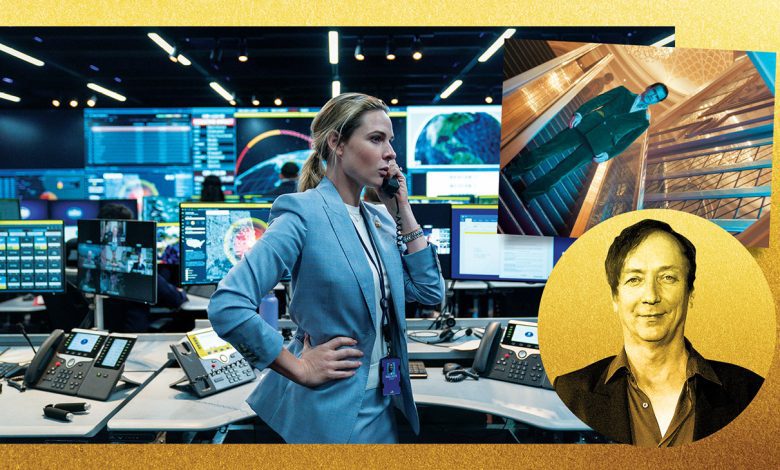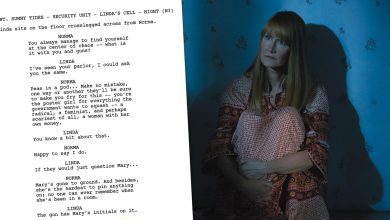The Music Score Behind Netflix’s ‘A House of Dynamite’

German composer Volker Bertelmann is no stranger to crafting scores that keep audiences, and even himself, up at night. “Yeah, I can’t sleep,” he jokes after being on the awards circuit with Edward Berger’s religious thriller Conclave last year while also working on the score for Berger’s next film, Ballad of a Small Player. Then he got the call that Kathryn Bigelow (The Hurt Locker, Zero Dark Thirty) wanted to meet to discuss her newest project, A House of Dynamite.
“Straightaway, I recognized that she’s very precise and she gives you a lot of time,” Bertelmann says of his first meeting with Bigelow. “I received a script, and it was really good. It was right up my alley because there was a lot of tension, but it was also very intelligently made.”
The veteran composer knew that the unique format of the film, plus its big ensemble of characters, would offer a distinctive challenge. “It wasn’t easy to score a film that has a lot of dialogue, that [takes place] mainly in offices with screens and that has a three-chapter [arc], where every chapter is, in a way, a repetition of the first one,” he explains. “In the beginning, I was like, ‘How can I approach that?’ I shook that [feeling] pretty fast.”
Netflix’s A House of Dynamite, streaming now, was written by Noah Oppenheim and stars Idris Elba, Rebecca Ferguson, Anthony Ramos, Jonah Hauer-King, Jason Clarke, Moses Ingram and Gabriel Basso, among others. The nerve-wracking, high-stress political thriller that chronicles how the U.S. government navigates a nuclear missile launch by an unidentified enemy is accentuated by Bertelmann’s tense and ominous score, comprising string orchestras and experimental piano.
The storyline repeats itself three times through the eyes of different characters in various branches of government but always reveals something new, which is exactly how Bertelmann approached his score.
“I tried to have repetition, but I didn’t try to create the impression that I’m repeating myself,” he says. “I always tried to end each chapter differently: The first one ends pretty quietly, and the next one, there’s a much higher ramp and a kind of ‘boom’ in a way. We tried to figure out, what’s an interesting way of making each chapter individual? Also, what I tried is to build these tension ramps in areas where the music drops suddenly, where you just see something and the music stops, and then it starts slowly getting back into the tension. You have these moments where you are left alone with tension. When you watch it, you always feel like, ‘Oh, what’s next?’ I tried to create irregularities in the film.”
His work with Bigelow didn’t differ much from his time on Berger’s films (Bertelmann has now scored six projects directed by Berger, including All Quiet on the Western Front). They both granted him a tremendous amount of freedom to get the score to a place he liked, after which he sat down with both filmmakers to discuss how far they could push it. But there were clear differences between Ballad and Dynamite, and even Conclave.
“In comparison to Conclave, the score of A House of Dynamite is much more heavy. There’s more pressure under the surface,” he explains, adding that originally he and Bigelow played with making the score for Dynamite even darker. “But then we felt like we are losing a little bit of the emotion and the feeling to the story. So we dialed it back again.”
Bertelmann’s score for Ballad, starring Colin Farrell as a chronic gambler in Macau, sat at the opposite end of the spectrum. “It’s very human, and it’s glamorous in the sense that it’s the road to hell,” he explains. “When I saw that film the first time, I had the feeling this guy is a little bit like a rock ‘n’ roller but on the way to hell, so what we tried was to find instruments that somehow represent that. I thought low brass instruments were the best to create that because you can play them very wild and create very awkward sounds. And on the opposite, you have very subtle woodwind arrangements that are, in a way, trying to connect with his soul in his search of freedom. … There was surrealness in the score and in the story.”
See more on the making of A House of Dynamite and other awards contenders at THR‘s dedicated site for behind-the-scenes stories at THR.com/behindthescreen.
HiCelebNews online magazine publishes interesting content every day in the movies section of the entertainment category. Follow us to read the latest news.





